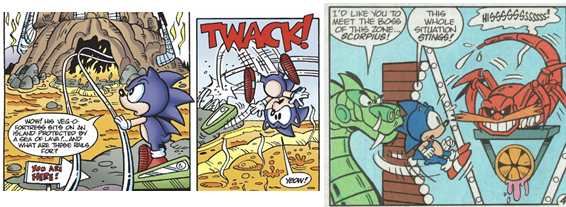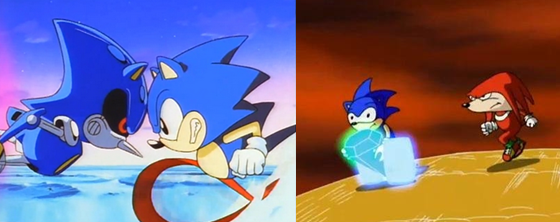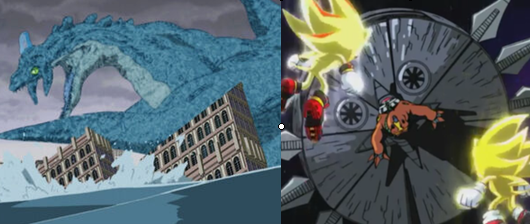
Among many things, adaptations can be described as being:
“An acknowledged transposition of a recognizable other work or works […] A creative and an interpretive act of appropriation/salvaging [or] An extended intertextual engagement with the adapted work” (Hutcheon, 2006: 80).
The great thing about adaptation is that it can be literally anything; it’s restricted only by the scope of your imagination and your commitment to researching the links between media. When I studied the writing of Linda Hutcheon (and many others like her) as part of my PhD, I chose to focus on the adaptation of videogames into movies, television shows, cartoons, and comic books.
There were two reasons for this: a) Because it’s a lot easier to talk about media adaptations like these and b) Because there hadn’t really been any real, serious research into videogames as adaptations. During my studies, though, I came across a curious statistic: of all the videogames that make up the entirety of the Sonic the Hedgehog (Sonic Team/Various, 1991 to present) franchise, there is one that stands out as having had the most adaptations and it’s probably not one you were expecting…
Today, we’re talking about Sonic the Hedgehog Spinball (Polygames/SEGA Technical Institute, 1993), a spin-off of the main Sonic the Hedgehog franchise. Spinball was the first Sonic title to truly embrace the pinball-like gameplay mechanics of the series popularised by the Spring Yard and Casino Night Zones.

Rather than being a fast-paced action/platformer, Sonic Spinball sees Sonic’s running speed scaled back and his bouncing speed boosted up as he trades running through loops for being flicked about inside a giant, pinball-like fortress created by Doctor Ivo Robotnik (now more commonly referred to as Doctor Eggman). Robotnik’s Veg-O-Fortress is made up of four stages, each one containing a number of Chaos Emeralds (unlike most Sonic games, Spinball has multiple Emeralds and they’re all blue). Using the flippers and a variety of gameplay gimmicks, Sonic must retrieve the Emeralds and battle the mad Doctor himself in a number of massive and increasingly difficult boss battles. In the Bonus Stages, Sonic operates an actual pinball and attempts to free his friends from Robotnik’s capsules. Other than that, the game offered little despite having some funky tunes and a charming aesthetic; the controls were clunky (Sonic feels unnaturally heavy and awkward), the stages were large and vibrant but it was often difficult to tell where you needed to go or what you had to do, and there’s very little incentive to play again except to beat your high score. Yet, Sonic the Hedgehog Spinball has been adapted into other media and forms more times than any other Sonic title; right off the bat, the game was ported to the Master System and Game Gear, for one thing, but, more than that, the game formed the basis of plots for Sonic’s cartoons, comic books, and other ancillary media.
At the time, Sonic was in the middle of his first (and, arguably, most prominent) surge in popularity; bundling Sonic the Hedgehog (Sonic Team, 1991) with the Mega Drive saw the console sell over fifteen million units during its American debut (Pétronille and Audureau, 2012: 39) and catapulted SEGA’s speedy mascot to the stratosphere. SEGA immediately followed this up with Sonic the Hedgehog 2 (SEGA Technical Institute, 1992) and, just like that, Sonic was everywhere. Not content with a gigantic Sonic balloon in the Macy’s Day parade, SEGA capitalised on Sonic’s popularity; Sonic appeared on every piece of merchandise imaginable and that, of course, included cartoons. Nintendo had seen significant success in this area in the past and, seeking to usurp their rival once more, SEGA turned to DiC Entertainment. The concept was spearheaded by producer Robby London, who recognised Sonic’s charisma and appeal but struggled with the “elusive and impenetrable” story of the videogames (Jones, et al, quoting London, 2011: 29). This isn’t particularly surprising as, while Sonic typically has an extremely simple premise (hedgehog hero destroys robots to save woodland friends), differences between the Japanese and American versions saw dramatically different versions of Sonic presented across the world.

Regardless, after bringing in Jaleel White to voice the character, DiC produced a pilot episode that was largely comprised of slapstick comedy and was deemed to be unsuitable for ABC’s Saturday morning slot. Undeterred, DiC made the extraordinary decision to instead produce two Sonic cartoons: one for weekdays and one for Saturday morning. This is how we ended up with Adventures of Sonic the Hedgehog (1993) and Sonic the Hedgehog (1993 to 1995, more commonly referred to as “SatAM”) airing simultaneously; one emphasised slapstick comedy and the other was decidedly much darker and serious in tone. For a time, these two cartoons were often closely associated with each other; this was mainly due to the Archie Comics series in the US initially mixing characters and concepts from both shows together rather than picking one as its basis (eventually, however, they settled on SatAM) but this can also be seen in Sonic Spinball. Sonic not only encounters Cluck, Doctor Robotnik’s (Jim Cummings) mechanical pet that briefly appeared in both SatAM and Archie’s comics, in the Toxic Caves, but must also free Princess Sally (Kath Soucie), Bunnie Rabbot (Christine Cavanaugh), Rotor (Mark Ballou), and Antoine Depardieu (Rob Paulsen) during the game’s Bonus Stages.

This would be the first and only time SatAM’s characters would appear in a Sonic videogame; given that, unlike Dr. Robotnik’s Mean Bean Machine (Compile/SEGA Technical Institute, 1994), Spinball appeared to be a straight forward spin-off of the main Sonic series, their inclusion only served to further muddy the waters as to the coherency of SEGA’s flagship franchise. To further confuse matters, it was the Adventures depiction of Robotnik (Long John Baldry), rather than SatAM’s, who appeared on the cover art for Spinball’s Game Gear port. Indeed, while Archie eventually restructured its Sonic comics into a continuation of SatAM, it was Adventures’ Robotnik who seeped into other Sonic media and became the default depiction of the dastardly Doctor in storybooks and comics for many years. This was most prominently seen (at least in the UK) in Sonic the Comic (1993 to 2002, referred to as “StC”) where, in issue tweny-two, Doctor Robotnik inexplicably transformed from the rotund antagonist seen in the videogames into “that weed from the rubbish cartoon series” (Fielding, 1995: 32; Kitching, et al, 1994: 1 to 7). While SatAM is often lauded as a significant influence to many for its darker, more adult themes, Adventures is often overlooked for its fidelity to the wacky nature of the videogames due to its childish humour. Of the two, only Adventures incorporated the game’s iconic theme song and more accurately depicted certain gameplay mechanics, such as Special Stages, Golden Rings, and Chaos Emeralds. Yet, don’t let that fool you: Adventures is a full-on acid trip most of the time and, despite pulling some inspiration for the source material, only ever adapted the plot of one videogame: Sonic the Hedgehog Spinball.
‘Attack on Pinball Fortress’ (Butterworth, 1993) saw Sonic, Miles “Tails” Prower (Christopher Welch) join forces with Sergeant Doberman (Phil Hayes) and one of Adventures’ more amusing reoccurring characters, Wes Weasely (Michael Donovan), when Robotnik threatens Mobius with a gigantic Stupidity Ray housed within his Pinball Fortress. When the group infiltrates the Pinball Fortress, they are knocked about by giant flippers and into other gigantic recreations of cliché pinball machines before they encounter Boss Scorpion, a massive robotic scorpion that Robotnik uses to try and thwart the heroes. Obviously, this fails and it isn’t long before the robot is devoured by lava and Robotnik’s plot is thwarted. As an adaptation of Sonic Spinball, ‘Attack on Pinball Fortress’ is very bare-bones; it’s almost as if the writer, Bob Forward, was given a few pieces of concept art and nothing more as the episode has next to nothing to do with the videogame beyond the vague concept of a pinball-themed fortress and a giant scorpion. Yet, as basic an adaptation as ‘Attack on Pinball Fortress’ is, it’s got nothing on ‘Game Guy’ (Myrick, 1994), an episode of SatAM that sees Sonic trapped within a pinball-themed game right at the conclusion of the episode, which mostly concerns Sonic and Sally being at odds over the appearance of another Freedom Fighter, Ari (Dorian Harewood). Ari betrays Sonic but, when Robotnik nearly uses his giant pinball table to suck Sonic into the Void, he sacrifices his freedom to not only save Sonic but lead the Freedom Fighters towards other allies. Literally the only thing in ‘Game Guy’ that comes from Sonic Spinball is the giant pinball-themed trap that Robotnik nearly bests Sonic with, but then this was par for the course for SatAM, which was concerned more with environmental messages than adapting plots from the videogames.

Things begin to look up, however, in ‘The Spin Doctor!’ (Gallagher, et al, 1994), the official Sonic Spinball adaptation featured in issue six of Archie’s Sonic the Hedgehog. Here, Sonic and the Freedom Fighters lead a random assault on Robotnik’s factory, only to be informed (via a hand-written note) that he has moved his base to Mount Mobius. Racing there without hesitation, Sonic finds the Veg-O-Fortress and is immediately attacked by (you guessed it) giant pinball flippers and bounced across lava. Racing up the pinball tracks and into the fortress, Sonic battles both Scorpius and Rexxon in the Toxic Caves, defeating them with ease. Sonic then ends up in the Lava Powerhouse, where Hip and Hop help lead him to a bunch of captive Mobians but giant plants force Sonic into a final Showdown…which consists entirely of Robotnik launching him out of the fortress using a giant spring. ‘The Spin Doctor!’ is little more than a glorified advertisement for Sonic Spinball; there’s just enough of the game’s premise, first stage, and other recognisable elements to inspire young kids to buy and play the game but not much else that directly links to it. Archie had a habit of doing adaptations of this kind; typically, they would produce a story that ended with the instruction to readers to play the videogame to find out the rest, despite the games and the comics being wildly inconsistent and at odds with each other. Other times, like this, they would attempt a very loose adaptation but be more concerned with servicing their own, unique narrative over anything.

Elements of this story were relegated to extremely minor roles or cameos; Scorpius, Hip, and Hop (two characters that serve only to launch Sonic into the Lava Powerhouse in the videogame) were amongst them but, while Mount Mobius did show up (and erupt) in the ‘Heart of the Hedgehog’ two-parter (Fingeroth, et al, 2000), the Veg-O-Fortress never appeared again. Finally, there’s ‘Spinball Wizard’ Millar, et al, 1996) from StC. In this story, Tails, disheartened at his lack of fan mail, attempts to drum up some support by cleaning up the Casino Night Zone and ends up being captured in Robotnik’s Spinball Murder Machine which is, wouldn’t you know it, a giant pinball table. Rushing to the rescue, Sonic is bounced around by flippers and seemingly defeated until Tails manages to free himself and use Robotnik’s “Hedgehog-crushing super pinball” (literally just a giant pinball…) to destroy the generator that powers the machine. And…that’s it. I mean, I gave Archie some flack over their adaptation but ‘Spinball Wizard’ is only very, very loosely drawing from Sonic Spinball; you could even argue it’s simply adapting elements of Casino Night Zone into its plot but I’m including it simply for the name of Robotnik’s machine. To be fair, StC was often fast and loose with its adaptations as well; they also favoured their own unique narrative over being slavish recreations of their source material. But we’re not quite done yet because a rollercoaster at Alton Towers was once rebranded as Sonic Spinball between 2010 and 2015. As you might have guessed, the rollercoaster has a pinball theme and, as part of its Sonic rebrand, featured red and blue tracks, songs from the videogames, and even commentary from Roger Craig Smith, Sonic’s current voice actor. So, just what was it about Sonic the Hedgehog Spinball that meant it formed the basis of so many adaptations? It was, even at the time, only ever an average title and far from the rich narrative resource as Sonic the Hedgehog CD (Sonic Team, 1993) or Sonic the Hedgehog 3 (Sonic Team/SEGA Technical Institute, 1993) yet these two latter videogames were only given the most basic of lip service and SatAM and didn’t factor into Adventures at all.

Perhaps it was the simplicity of the concept: Sonic bounces around like a pinball in comics and cartoons anyway, so maybe it’s easier to literally stick him into a giant pinball machine than have him race a robotic version of himself or go head-to-head with Knuckles the Echidna? Other anime and cartoons managed to include these two elements, however, and quite successfully in some cases, so it does remain a source of wonder (if not outright confusion) that Sonic Spinball, of all Sonic games available at the time, should be returned to and adapted so often. A large part of the explanation probably can be traced back to Sonic’s growing popularity at the time; Sonic Team USA had invested a considerable amount of time, effort, and money into rebranding Sonic for his US debut and crafting an entirely unique backstory that was completely different to the one found in Japan (and quite separate from the one in the UK, as well). Sonic Team, SEGA, and DiC seemed to see Sonic Spinball as a natural bridge between the videogames and the cartoons; they were certainly enthusiastic about the tie-in enough to insert their cartoon characters into the videogame and onto the art work (Hazeldine, 2014: 35).

Perhaps there was no need to mine other Sonic titles; Sonic’s popularity didn’t begin to wane until the end of 1996 and, by then, both cartoons had finished producing new episodes, Archie’s comics and StC were content with forging their own narratives, and Sonic was firmly established as a successful and popular videogame icon in the cultural consciousness. Sonic X (2003 to 2006) would later produce surprisingly faithful adaptations of both Sonic Adventure (Sonic Team, 1998) and Sonic Adventure 2 (Sonic Team USA, 2001), while also loosely adapting Sonic Battle (Sonic Team, 2004) and appropriating many elements from Sonic Heroes (Sonic Team USA, 2003) and Shadow the Hedgehog (SEGA Studio USA, 2005). These all saw adaptations in Archie’s comics and StC (except for the latter four, at least officially, as StC had ceased publication by that point) but no other Sonic the Hedgehog videogame can boast as many adaptations as Sonic the Hedgehog Spinball, a largely average and arguably insignificant spin-off that nevertheless defined the golden age of Sonic across all forms of media.

What do you think about Sonic Spinball and its adaptations? Can you think of any other videogames that received undue attention in other media? Leave a comment below and join me next time for more interplay.



14 thoughts on “Interplay: Sonic the Hedgehog Spinball”